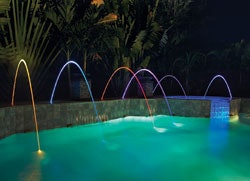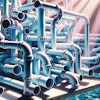
One of the best ways to do the latter, according to Mike Crnkovic, international director of business development for Crystal Fountains Pool and Spa, is to sell more to the customers you've already got building contracts with. He loathes the term "up-sell," but there doesn't seem to be an apt alternative.
"As much as that's a term that we don't want to use," he says, "it's a practical reality in hard times like these."
Up-selling with fountains does more than increase the ticket price; it also differentiates you from the three or four other price-based quotes the customer's got in hand. That's a key consideration, says Zack Pickard, product manager for Pentair Water Pool and Spa's water features line.
"In my experience one of the things that can really close the deal is water features," he says. "A pool owner is not just buying the experience of having a place they can jump in and splash around. To me water features are the thing that really sets a pool apart from being just a recreational pool to being something that is really visually interesting, with light, sound and visual texture of water flowing in your backyard. It's the icing on the cake.
"And when the customer is already spending as much as they're spending on a pool, going a little further and adding a water feature is an easy up-sell."
Vertical Integration
A vertical water feature, for the uninitiated, is simply one where the water is thrown vertically, whether in a neat and clear stream, an arcing sheet of water or a bubbling effect that adds the sound of crashing water.
Crnkovic's company, which has been in the architectural fountain industry, mostly commercial, since the mid-'60s, recently introduced a line of flush-mounted fountain components aimed at the residential market. These components are relatively simple to sell and incorporate into pool plans, he says, so long as one's willing to learn a little about some of water's general characteristics and can translate a customer's wishes into the vernacular of the fountain builder.
"There are those builders - the early adopters in the industry - who move right along with us and other fountain component manufacturers. But there are also those who are looking to put in their very first fountain feature," he explains. "There are people who look at it like, 'I have to put on a separate water feature. I have to do some extra plumbing.' And they have waited for a while, getting comfortable with the idea, and now they're putting them in for the first time."
To help those builders, Crystal works closely with its customers to demystify the process, knowing it's difficult for a builder new to water features to spec the proper pump and pipe sizes necessary to make the feature work.
"We provide cut sheets for our customers with all the necessary information to do a successful installation," Crnkovic says. "If people still have questions, and they often do, we invite them to call. We have people calling us every day: 'I'm going to put in this feature. Can you tell me if I've got the right pipe size? Can you tell me if I'm doing the manifold correctly?'"
What Can Be Done?
Water features designed into pool projects can achieve a variety of effects, from traditional and formal to more natural or stylized looks. Each environment is different and several factors need to be considered.
"We generally believe that vertical water features provide the most dramatic and powerful effects. With this in mind, the challenge is to determine the client's needs, assess the site, consider the installation and take into account architectural references, as well as operational requirements, to produce water features that are both practical and beautiful," Crnkovic says.
Among the most-dramatic of these fountain effects is the laminar, which shoots a clear, unbroken stream of water up and out over a pool.
"It's an amazing thing that the water can actually shoot up and out so forcefully without spraying apart into droplets," Pickard says. "There's a lot of water, and even though it looks really light, there's a lot of weight to it. But because of the way the water is forced out of the jet it can go 7 or 8 feet up and 7 or 8 feet out into the water without having a single droplet come out of the stream. That's what sets it apart from everything else."
One of Pickard's favorite ways to use laminars is on the far end of smaller pools, the assembly hidden by plantings.
"When you turn it on you've got this jet of water that seems to appear out of nowhere and it's going into the pool," he explains. "And because it's lit from within with LEDs, what you're doing is taking something from what was just a backdrop of plantings on the far side of the pool and visually elongating the pool itself. If the pool was smallish and the laminar was several feet back, now there's stuff going on in a larger area."
Laminars are also good choices for customers who want a quieter water feature because the focused stream enters the water so smoothly.
"There's actually an installation I'm going out to see tonight after dark," Pickard says. "It's a relatively small, black pool that has 16 individual laminars. Some people will say that it's a 'silent' water feature. Well, it's not silent, but it's possible to have 16 on this one small pool without it sounding like the ocean is lapping at the door."
For homeowners who want a bit of an oceanic roar in the backyard, Pentair, Crystal and other manufacturers offer fountain products that shoot broken streams of water into the pool. These can be good choices in areas where traffic noise or loud neighbors are a concern. Crystal calls its splashier arcing fountain features Stream Jets and recommends using multiple units to create a canopy or arcing water on more-formal installations.
Sound, Crnkovic adds, is a factor that's too often overlooked when fountain features are chosen.
"In creating aesthetic water features, the nature of the required effect is crucial; in other words, it is imperative to establish the maximum acceptable level of noise," he says. "Too little, like a dripping tap, and be irritating, and too much, particularly in smaller areas, can be overpowering."
Again, Crnkovic emphasizes the need to listen to customers to determine which product or combination of products will give them the overall effect they're looking for.
"Many times, people will come to you and just talk in generalities," he says. "They may want dancing water, they may want white. A swimming pool builder has to become conversant, to some degree, regarding the design aesthetics of fountains.
"It's pretty simple really. If the consumer is waving his arms and saying, 'I'd like to see something like this!' it's the pool builder's job to try to figure out what exactly it is that they want. Do they want bright LEDs and a Vegas-at-night look, or do they want calm, serene water punctuated by streams. Do they want interactivity on the edge of the pool? Full computer control? These are the kinds of things we encourage builders to become conversant with. And once they gather the information, they can begin."
Designing For Flexibility
Customers rarely fall into neat arrangements of those who want quiet and those who want noise, or those who want glassy streams and those who want a little white in their water. Most prefer a bit of each, with the ability to operate different features to suit their moods.
"Every water feature, whether it's a waterfall, laminar or deck jet or anything else," says Pickard, "should always be installed on a separate valve so when the pump is turned on and the pool owner is standing there looking at it, he or she can go around to the equipment area and adjust the height and the flow and the range of each feature individually.
"Somebody will always say, 'Aw, I wish the waterfall wasn't gushing so much. And why is the Deck Jet only dribbling out?' Well, if everything is on an individual valve then it can all be fine-tuned. So you can have a laminar that's shooting up and out and entering the pool cleanly, and then next to it on either side you can have two jets that are doing more of a spurting, tumbling effect, and you can have either or both on."
Crnkovic's company also places great emphasis on flexibility and designing features that can be used in a variety of ways.
"We like to think that during the day kids can play in the play-safe water features and then at night you can valve the features up and have something that's exciting for adults," he says, adding that because kids are attracted to the features, it's important to keep flow under control. "People like to crank up fountain features and shoot them 10 feet in the air. That's all well and good, but we have to remind them to keep the velocity down to 20 feet per second or less. That's because children have tendency to want to stand on deck-mounted water features, put their eyes up to water features and look at the water stream as it comes out. But if people follow our instructions, there'll be no harm and people will be able to enjoy themselves safely in the pool."
Site Considerations
In addition to translating customers' desires and choosing appropriate features, then valving them separately and advising homeowners on how to use them safely, builders looking to incorporate fountains into pool projects need to be aware of other factors that could affect the success of the installations. Wind, particularly, needs to be accounted for.
"Implementing pool nozzles and fountains requires more skill in a windy environment," Crnkovic explains. Wind changes the flat, mirror plane surface of water to create stormy, white-capped waves. Vertical water features in both [architectural] fountains and pools can spray outside the pool in high winds if not planned for in advance.
"If there's a wind that's going to be coming across the property every day, you know what? The laminar is not an appropriate feature. We tell them straight up in cases like that not to bother with laminars and instead use a Stream Jet with a lower throw, or maybe a Fyrefly nozzle, which mount to the deck and project fine fingers of water out into the pool in either a spray a more linear pattern."
Similarly, if a homeowner has a brightly lit property, illuminated features might be inappropriate, Crnkovic adds.
It all comes back to careful consideration of customers' desires, an understanding of the effects different components make and not being afraid to call on the manufacturers for the expertise they're able and eager to provide. If your competitors are doing that, you'd better be, too. And if they're not?
"Adding a water feature to a pool is an opportunity for the pool builder to differentiate their services and introduce a new source of revenue," Crnkovic says. "Introducing water features into a pool presentation to the homeowner is simple, and often they do not know that they can have a pool and fountain combined for only 5 to 8 percent extra.
"A fountain feature brings a flat pool of water to life by introducing vertical elements, and they create entertainment for the observer, and extra fun when the pool is in use."







































